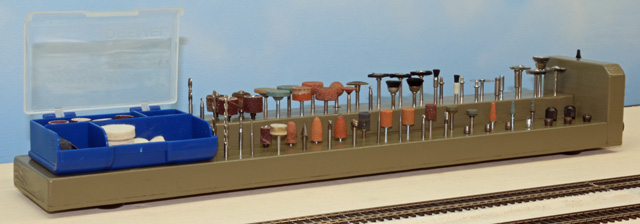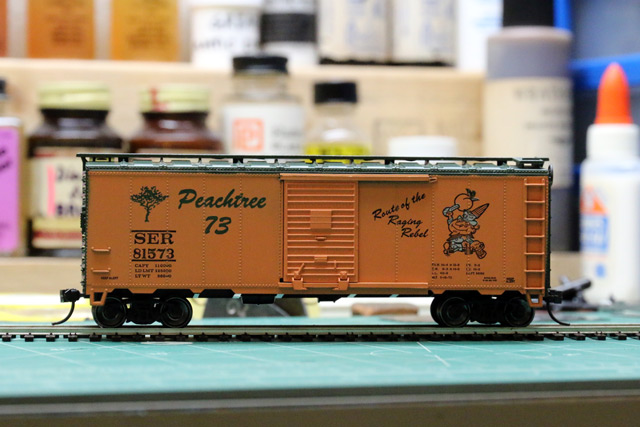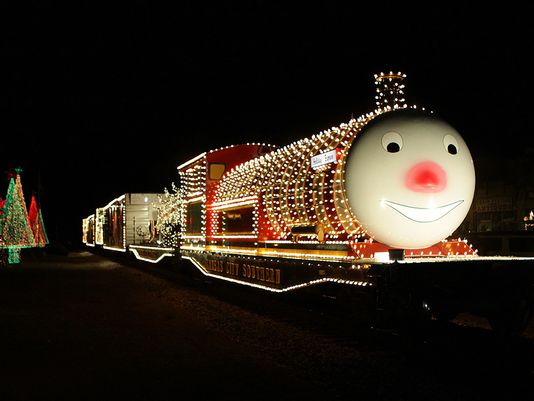Well, we are wrapping up year number three on the Louisiana Central. Much work has transpired over this past year, though not nearly as much trackwork was completed as I would have liked. But significant progress has been made nevertheless. All of the basic benchwork is completed, however two of the five sections are still needing roadbed for the track. Benchwork fascia has been installed along a substantial section of the center aisle and at Maynard adjacent to the rear wall.
Electrical districts have been clearly defined and the DCC power, cab and booster bus wiring for five of the seven districts is complete. The optical detection system was completed with the exception of the panel indicators (which need panels before that happens). The first four control panels have been constructed and test fitted into their fascia “frames”. A few hours of wiring will see them completed. I’m pleased with these initial panels as they present a neat, clean appearance and are recessed to resist damage from passers-by.
While trackwork has lagged, a good bit of it has indeed been installed. All of the staging tracks are in, and the entire Illinois Central presence is complete. The interchange to the Louisiana Central has been laid, and the passing siding at Willis yard is nearly complete. At the Monterey end of the line the mainline and passing siding have been installed, along with the turning wye, the house track, the MOW track, the Texas and Pacific interchange, and a spur to the Sean Cannery Company. All of the trackage at Maynard was completed some time ago.
The Spencer Lumber Company’s line up to Camp 6 in the woods is under construction. The upper roadbed is installed and waiting for track. As I’ve mentioned before, that trackage needs to go in before the Louisiana Central can advance it’s mainline west out of Maynard. The hang-up (as I’ve also mentioned) has been the modification of about 40 Shinohara code 70 switches to make them “DCC friendly”. Well, the good news is that the program has finally started. It shouldn’t be long before that trackage starts going down.
Speaking of trackage, I’ve installed the Tortoise switch motors on those turnouts presently down. And I’ve got a good stash of Tortoises that have been inspected, lubed, pre-wired, and are ready for installation as additional track is laid.
I started roughing in for a bit of scenery recently. There is a stretch between Willis and Maynard that consists only of the track on 2″ wide roadbed. I thought it might be prudent to at least install the hardshell scenery base between the roadbed and the fascia and also a bit to the far side of the track just to make sure nothing takes a quick trip to the valley floor 385′ below.
Oh, and car kits . . . I’ve started assembling some car kits. I’ve completed nearly 50 kits now (of the 300 or so kits in my stash). Admittedly, I started with the low hanging fruit, going through many Accurail kits, along with a few Walthers, Atlas and McKean. All of these cars now have metal wheelsets and Kadee couplers, and all have been certified road worthy.
Plenty of other things have been done, some not directly related to the layout (shelving in the workshop, drill press table, Dremel bit rack, and a few other improvements). Even a bit of lighting work was done.
All-in-all, it really wasn’t a bad year. During the second year, I had started burning out on construction. The vast majority of the work had been on benchwork, roadbed and some track. I decided to broaden the scope of work on the layout and began putting more time in on the other aspects of the layout. After all, the layout will not become operational until all these things are done, including some basic scenery (as mentioned above). After a long break from trackwork, I’m now in the mood to tackle some more and have refocused on that task again.
I had decided during my last annual assessment to not make predictions of what I’d accomplish in the upcoming year, then promptly made a prediction (which of course, failed to materialize). This year I’m sticking to that tenet.
However, I’m optimistic about the fourth year ahead.
-Jack




